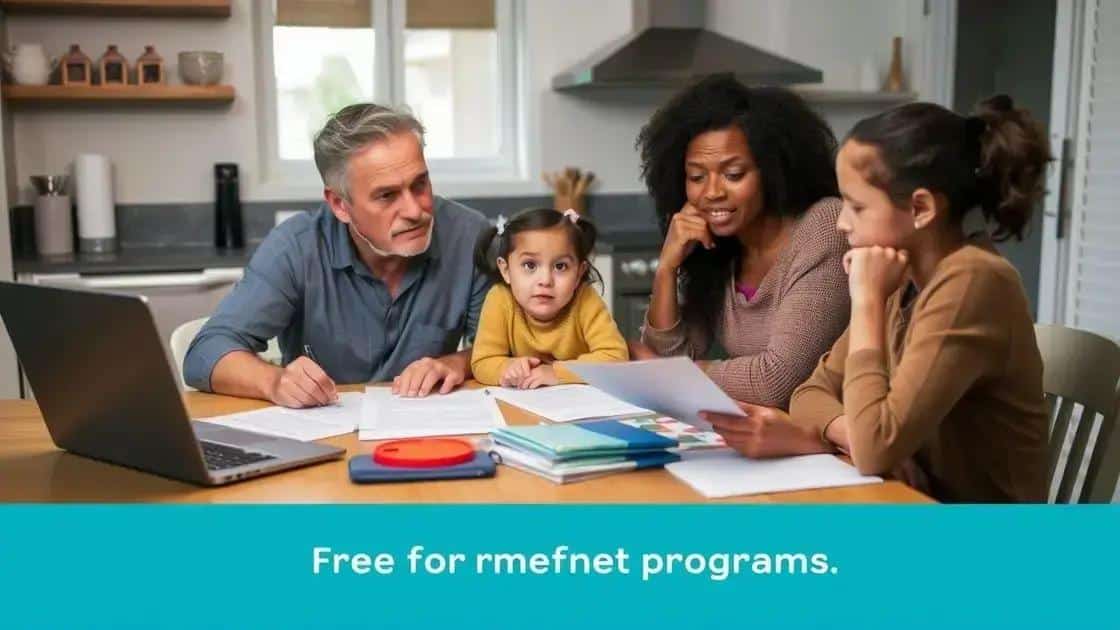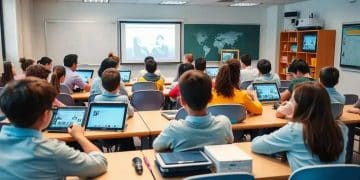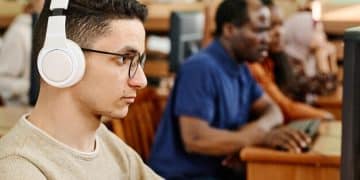Free internet programs for students: Get connected today

Free internet programs for students provide essential connectivity for online learning, improving access to educational resources, enhancing communication with teachers, and promoting academic success.
Free internet programs for students can make a huge difference in educational outcomes. Have you ever thought about how access to the internet impacts your studies? Let’s dive into the options available that can help you succeed.
Top programs offering free internet access for students
Many students today struggle to access the internet, which is crucial for their education. Fortunately, there are several programs designed specifically to provide free internet access for students. Understanding these programs can help you take advantage of the resources available.
1. The Lifeline Program
The Lifeline Program provides discounts on phone and internet services for low-income families. Students can benefit from this program, which significantly reduces monthly bills. Enrollment is simple, and eligibility is based on income levels.
2. FCC’s Emergency Broadband Benefit
This initiative offers discounts on broadband internet service for qualifying households, including students. It allows families to save money while obtaining vital internet access for educational purposes. The benefit can be used with various participating service providers, making it versatile.
3. Local Library Programs
Many public libraries offer free internet access and even loan Wi-Fi hotspots. This is an excellent option for students who need reliable internet but might not have it at home. You can research library programs in your area to find options that work for you.
4. School District Initiatives
Some school districts have taken the initiative to provide free internet access to their students. By collaborating with local internet service providers, they ensure that every student can connect to learn. Reach out to your school to see if they offer any such programs.
These programs collectively aim to ensure that education remains accessible, especially in challenging circumstances. By leveraging these resources, students can close the digital divide and enhance their learning experiences. Don’t hesitate to explore these opportunities to improve your internet access.
How to apply for free internet programs

Applying for free internet programs can be straightforward if you know the steps. Many programs are designed to make the process easy for students and families needing help.
1. Gather Required Documents
Before starting your application, it’s essential to have all necessary documents ready. Most programs require proof of income, school enrollment, and identification. Having these documents organized will speed up the process.
2. Visit Official Websites
Start by visiting the official websites of the programs you are interested in. They will provide detailed instructions on how to apply. Many programs offer online applications, simplifying the process.
3. Complete the Application
Fill out the application form carefully. Ensure that all information is accurate, as errors can delay approval. Many applications also have a section where you can provide additional information about your situation.
5. Follow Up
After submitting your application, it’s a good idea to follow up. If you haven’t heard back within a few weeks, contact the program’s support line. They can provide updates on your application status.
Remember, applying for these programs can open doors to improved education opportunities. Utilizing resources like schools and community centers can also help you navigate the application process effectively.
Benefits of having free internet access for education
Having free internet access for education offers numerous advantages that can significantly impact a student’s learning experience. With reliable internet, students can engage more effectively with their studies.
1. Enhanced Learning Opportunities
Free internet access expands learning opportunities for students. They can access online resources, educational videos, and virtual classrooms. This access means that students can learn at their own pace and explore subjects that interest them.
2. Improved Academic Performance
Research indicates that students with internet access often perform better academically. They can submit assignments on time, participate in discussions, and collaborate with peers easily. This connectivity fosters a supportive learning environment.
3. Access to Educational Tools
With free internet, students can utilize various educational tools. These may include online tutorials, interactive quizzes, and digital libraries. Such resources can make learning more engaging and effective.
4. Better Communication with Teachers
Students can communicate easily with their teachers outside of school hours. This connection allows for questions, feedback, and assistance to happen in real-time, promoting a more responsive educational experience.
Additionally, families can stay informed about their child’s education through online portals and resources. Overall, free internet access plays a vital role in modern education, making learning more accessible and enriching for all students.
Challenges in accessing free internet programs

Accessing free internet programs can be very beneficial, but it does come with its challenges. Understanding these obstacles can help students and families better prepare for the application process.
1. Limited Awareness
Many students and families are simply unaware of the programs available to them. Information may not be widely circulated, causing missed opportunities. Schools and community organizations play a crucial role in spreading awareness about these offerings.
2. Complex Application Processes
Some free internet programs have complicated application procedures that can discourage potential applicants. Filling out forms and providing documentation can be overwhelming for those who are not tech-savvy. Streamlined processes can increase participation.
3. Eligibility Criteria
Eligibility requirements can vary widely between programs. Some may require proof of income or specific academic standing. This can create barriers for families that may need the help but do not meet all criteria.
4. Availability of Service Providers
In some regions, there may be limited options for internet service providers, which can restrict access to free programs. Rural areas, in particular, often face greater challenges in securing reliable internet services.
Additionally, even when programs are available, the demand may exceed the supply, leading to waiting lists. This can create frustration for students and families who are eager to improve their access to education resources. Addressing these challenges is essential to ensure that everyone can benefit from free internet access.
Access to free internet programs for students is essential for bridging the gap in education. While there are numerous benefits such as improved academic performance and enhanced learning opportunities, challenges still exist. It’s vital for families to stay informed about the available programs, understand the application processes, and navigate the eligibility requirements. By working together, communities can ensure that every student has the chance to succeed in a connected world.
FAQ – Frequently Asked Questions about Free Internet Programs for Students
What are free internet programs?
Free internet programs provide students with access to internet services at no cost, ensuring they can participate in educational activities online.
How can I apply for these programs?
You can apply by visiting the official websites of the programs, gathering necessary documents, and completing the application forms online.
What benefits do students gain from free internet access?
Students gain access to online learning resources, improved communication with teachers, and a better overall educational experience.
What challenges might I face when applying?
Common challenges include a lack of awareness about available programs, complicated application processes, and varying eligibility criteria.





